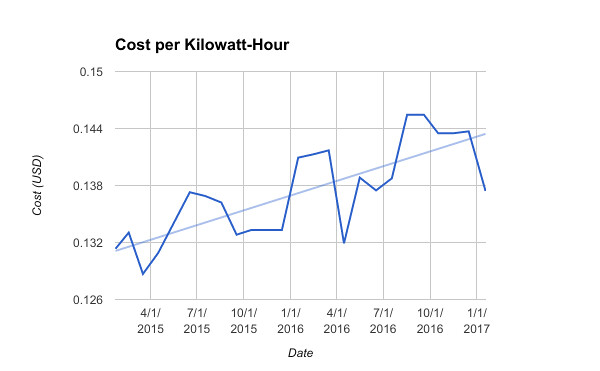Two Years with Solar
It's been two years since I installed solar panels on my roof and things are going great:
86% of my home's electricity needs have been provided by the sun.
60% of my installation costs have been recouped through incentives, reduced reliance on my utility's electric supply, SREC sales, and even a referral bonus from my installer.
What else has happened?
I've become more hands off. The system just works and I don't feel compelled to check on it as often as I did when it was first installed. I still record the production numbers off the production meter once a month, but day-to-day I just go about my business. Pollen and grime accumulates on the panels and then is washed off when it rains; some might climb up and clean, but I feel the potential for increased production isn't worth the risk of falling off the roof.
As soon as your system is installed, you end up becoming an advocate and information resource. I frequently answer questions about my solar panels, as well as general questions about solar energy. Lots of people are curious. That hasn't changed over the past two years.
Solar installs are occurring all over my neighborhood. I can see three from my living room window, there's probably ten within a three minute walk of my house, and Google Maps reveals several dozen others.
That's the good news, but there have been a few hiccups.
SREC Market Tanked
From my initial estimates, I expected the following income from SREC sales:
$2,350 in SREC sales over the first 14 years (assuming 40¢ on the dollar of SACP
I was way off.
Though the SREC market was relatively stable from 2007-2014, the large uptick of installed solar capacity -- although great in general -- has not been good for the Maryland SREC market. In August 2015 the price of a single SREC was $165 but a year later it had dropped to $28. If state-mandated renewable energy goals are increased the price of an SREC may rise again, but I don't count it as sure income.
Assuming worst case of no significant income from future SREC sales, that leaves an extra $1,600 to recoup installation costs through other means, likely from an extra 2-3 years worth of utility reduction. Perhaps less time, given the rising cost of electricity.
Cost of Electricity
Over the past two years the cost of electricity has been on the rise, slowly.
One financial perk of solar is decreased reliance on utility-provided electricity. Although I pay the same for rate per kilowatt-hour for electricity as my non-solar neighbors, I consume less of it, insulating me from rising costs.
As the cost of electricity rises, the faster my utility savings pay down the cost of installation.
Production Shortfalls
On average, the solar PV array produces the vast majority of my monthly electricity (94% mean, 82% median). In the spring and early summer the PV array produces more electricity than I need; I receive negative invoices from my utility until the summer heat and humidity rolls in and I'm forced to switch on the air conditioning.
In the first two years, the solar PV array produced 86% of my household's electrical needs (which I'm quite pleased with), but not as much as was warranted:
- 2015: shortfall of 782 kWh (-16%)
- 2016: shortfall of 632 kWh (-13%)
Photovoltaic production models are based on historic weather data for your region, the array's configuration (elevation, angle, and pitch), and probably a bit of actuarial science thrown in for good measure. Changes in shade are the most common reason for production shortfalls, but faulty components could also be to blame, as could a departure of the weather from the predicted model.
There's no trees above my house, so there was no change in shading. The shortfall wasn't considerable enough to suggest component failure (less a brief motherboard failure which wouldn't have accounted for more than 10-20 kWh maximum), so it's likely the last two years weather didn't align with the model. We did have some pretty heavy storms in the summer that may have contributed or maybe the model didn't account for global climate change or seasonal pollen.
This is why it's important to have a production warranty included as part of your installation contract.
With a production warranty, your vendor agrees to reimburse you for the electricity the panels were warranted to produce (but didn't). This will cover you in the case of bad panels, parts, or wiring, but also in the event the original production estimates were off. I'm pleased to report that my vendor reimbursed me promptly for the shortfall as per our contract, so I've got no reason to fret about underproduction.
Continuing On...
Two years in, the sun is still shining. I'm still pleased with my decision to install solar PV panels on my home.
Last Modified: 2020-08-09
§
Home | All Entries | Search | Errata
Copyright © 2014-2024 Alex Moundalexis, licensed under a Creative Commons License. Some rights reserved.
